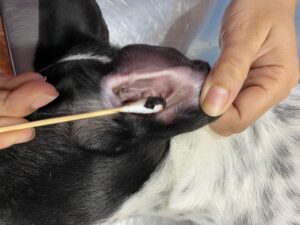When our canine companions start shaking their heads more than usual or scratching their ears incessantly, it’s not just a quirky behavior but often a sign of discomfort that shouldn’t be ignored.
Ear infections in dogs are not only common but can also significantly impact their quality of life, causing a range of symptoms from mild irritation to severe pain. These infections can affect any dog, regardless of breed, age, or lifestyle, making it a prevalent concern for all dog owners.
The reasons behind ear infections are varied, encompassing factors like moisture retention, allergies, the presence of ear mites, excessive wax buildup, and even the unique anatomy of a dog’s ear. Breeds with floppy ears, for example, are more susceptible due to reduced air flow, creating a warm, damp environment where bacteria and yeast thrive. Other times, something as simple as water trapped during a bath can set the stage for an infection.
In this blog post, we have revealed the common causes of ear infections in dogs. We’ll also guide you through how to recognize early signs of ear infections in dogs, how veterinarians diagnose these infections, discuss various treatment options available, and offer tips on prevention to keep your dog’s ears healthy
Without further ado, let’s begin!
Types of Ear Infection in Dogs

One of the most distressing ailments affecting dogs of all breeds and ages is ear infections. As a responsible dog owner, understanding the types of ear infections is crucial for early detection and effective treatment.
Dogs can suffer from three primary types of ear infections, each named for the part of the ear they affect:
1. Otitis Externa
This is the most prevalent type of ear infection in dogs, targeting the external ear canal. It’s characterized by inflammation that can lead to redness, discharge, and discomfort. Dogs with floppy ears or those that swim frequently are especially susceptible to otitis externa because their ear structure and activities can trap moisture and debris, creating an ideal environment for bacteria and yeast to flourish.
2. Otitis Media
This type of infection occurs in the middle ear, often as a complication of an untreated external ear infection. It can be more challenging to diagnose because the symptoms might not be as obvious from the outside. Otitis media requires prompt veterinary attention to prevent it from progressing to more severe conditions.
3. Otitis Interna
The most serious form of ear infection, otitis interna, affects the inner ear and can lead to vertigo, imbalance, and even hearing loss if not treated promptly. This type of infection often results from an extension of a middle ear infection and can have significant neurological implications.
Symptoms of Dog Ear Infection
Each of the three types of this infection can cause a range of symptoms, from mild discomfort to severe pain, and can significantly impact a dog’s quality of life.
Below are the common symptoms of ear infections in dogs:
- Frequent head shaking or tilting.
- Incessant scratching of the affected ear.
- Discharge, odor or redness in the ear.
- Swelling or warmth around the ear.
- Behavioral changes such as increases irritability and aggression.
Causes of Dog Ear Infection
Understanding the causes of ear infections in dogs is essential for prevention and effective treatment. While various factors can contribute to the development of an ear infection, some of the most common include:
- Moisture: One of the primary culprits behind ear infections is moisture, which can get trapped in the ear canal, creating an ideal breeding ground for bacteria and yeast. Dogs that love to swim or are bathed frequently without proper ear drying are at higher risk.
- Allergies: Dogs, like humans, can suffer from allergies. Allergic reactions to food, pollen, or environmental factors can lead to inflammation of the ear canal, making it susceptible to infection.
- Ear Mites: Particularly common in puppies, ear mites are tiny parasites that live in the ear canal, causing intense itching and inflammation, which can lead to secondary infections.
- Wax and Debris: Excessive accumulation of ear wax and debris in a dog’s ear canal can block ventilation and create a fertile environment for bacteria and yeast to grow.
- Foreign Bodies: Grass seeds, dirt, or other foreign objects can become lodged in a dog’s ear canal, leading to irritation, inflammation, and infection.
- Anatomy and Genetics: Certain breeds with floppy ears or narrow ear canals are genetically predisposed to ear infections due to restricted airflow and a propensity to retain moisture and debris.
- Hormonal Imbalances: Conditions like hypothyroidism can alter the skin’s barrier function, making ears more susceptible to infection.
- Autoimmune Diseases: Dogs with immune-mediated diseases may have a higher incidence of ear infections due to compromised immune defenses.
- Trauma: Scratching or vigorous cleaning can damage the delicate skin of the ear canal, leading to inflammation and infection.
Diagnosing Dog’s Ear Infection
To diagnose dog’s ear infection, veterinarians usually rely on a combination of clinical signs, thorough history taking, and a series of diagnostic tests to confirm the diagnosis.
Identifying an ear infection early and accurately is crucial for effective treatment and preventing potential complications. Here’s an overview of the common methods and procedures vets use in diagnosing ear infections in dogs:
1. Clinical Examination
The process begins with a detailed examination of the dog’s overall health and behavior. Vets look for common signs of discomfort or distress, such as head shaking, scratching at the ear, or tilting the head to one side. Examining the ear externally for signs of redness, swelling, discharge, or odor provides initial clues.
2. Otoscopic Examination

This is a critical step where a specialized instrument called an otoscope is used to look deep into the dog’s ear canal and eardrum.
It allows vets to visualize the condition of the ear canal and tympanic membrane (eardrum), identifying any inflammation, foreign bodies, polyps, or other abnormalities.
This procedure requires a calm and cooperative patient, and in some cases, mild sedation may be necessary for a thorough examination.
3. Cytology
One of the most informative tests, cytology involves collecting samples from the ear discharge and examining them under a microscope.
This test helps identify the presence of bacteria, yeast, or ear mites, determining the type of infection and guiding the appropriate treatment plan.
The technique involves gently swabbing the ear canal, staining the sample, and then viewing it under a microscope.
4. Culture and Sensitivity Testing
If the infection appears severe or recurrent, or if the initial treatment fails, a culture of the ear discharge may be necessary. This test helps identify the specific bacteria or fungi causing the infection and determines which antibiotics or antifungal medications are most effective against it. It’s particularly useful in cases where antibiotic resistance is a concern.
5. Blood Tests
While not always necessary for diagnosing an ear infection, blood tests may be recommended to check for underlying conditions that could contribute to chronic or recurrent ear infections, such as allergies or hormonal imbalances.
6. Imaging
In cases where a deeper infection is suspected, such as otitis media or interna, further diagnostic imaging like X-rays or an MRI may be needed to assess the extent of the infection and involvement of the middle or inner ear structures.
Treatment of Dog Ear Infection
Treating an ear infection in dogs involves a multi-faceted approach that targets both the underlying cause and the symptoms to provide relief and prevent recurrence.
Veterinarians tailor the treatment plan based on the type of infection (otitis externa, media, or interna), the severity of symptoms, and the underlying cause identified during diagnosis.
Below is a comprehensive overview of the treatment plan for dog ear infections:
1. Cleaning
The first step in treating an ear infection is thorough cleaning of the ear canal to remove accumulated debris, wax, and discharge.
This is often done in the veterinary clinic to ensure it’s performed correctly and safely. For severe cases, sedation may be required to clean the ears without causing discomfort or stress to the dog. Owners are also instructed on how to safely clean their dog’s ears at home as part of the ongoing treatment plan.
2. Topical Medications
After cleaning, topical treatments are usually the first line of defense. These may include ear drops or ointments that contain a combination of antibiotics, antifungals, and steroids to combat infection and reduce inflammation.
The specific medication chosen depends on the type of pathogens identified (bacteria or yeast) and whether inflammation is a significant component of the infection. Proper administration of these medications is crucial for success, and your vet may also demonstrate to you how to apply them correctly.
3. Oral Medication
In cases where the infection is more severe or if the dog has a history of chronic infections, oral antibiotics or antifungals may be prescribed in addition to topical treatments.
Oral steroids may also be used to reduce severe inflammation and discomfort. The choice of oral medication depends on the results of the cytology and culture tests, ensuring the most effective drug is used against the identified pathogens.
4. Surgical Intervention
For chronic infections that do not respond to medical treatment or in cases where structural abnormalities contribute to the infection (like narrowed ear canals), surgery may be necessary.
Surgical options include procedures to improve airflow within the ear canal or, in extreme cases, removal of the ear canal (total ear canal ablation). Surgery is considered a last resort but can significantly improve the quality of life for dogs with recurrent ear infections.
5. Management of Underlying Causes
Simultaneously, any identified underlying causes, such as allergies or hormonal imbalances, must be addressed to prevent future infections. This may involve dietary changes, allergy medications, or other long-term management strategies.
6. Follow-up Care
Monitoring the dog’s progress through follow-up visits is essential to adjust the treatment plan as needed. Repeat cytology may be performed to ensure the infection is resolving, and adjustments to the medication regimen are made based on the dog’s response to treatment.
How to Prevent Ear Infections in Dogs

Preventing ear infections in dogs involves a combination of routine care, monitoring, and environmental management. Here are some additional preventive measures to complement regular ear cleaning and keeping ears dry:
- Regular Ear Checks: Make examining your dog’s ears a part of your routine pet care. Look for signs of redness, discharge, or odor that could indicate a developing infection. Early detection can prevent an infection from becoming severe.
- Proper Nutrition: Feeding your dog, a balanced diet can support their overall health and immune system, reducing the likelihood of ear infections. Some dogs may benefit from a diet formulated to reduce allergies, which are a common cause of ear infections.
- Avoid Over-Cleaning: While keeping your dog’s ears clean is important, over-cleaning can irritate the ear canal, leading to inflammation and infection. Only clean your dog’s ears as recommended by your veterinarian, using a solution specifically designed for dogs.
- Grooming and Hair Trimming: For breeds with long hair around the ears, regular grooming and trimming can help improve airflow to the ear canal, reducing the accumulation of moisture and debris that can lead to infections.
- Manage Allergies: If your dog has allergies, managing them effectively can prevent ear infections. Allergies can cause ear inflammation, making them more susceptible to infections. Work with your veterinarian to identify and manage your dog’s allergies through diet, medication, or other treatments.
- Use of Preventive Products: If your dog is prone to ear mites or other parasites that can cause ear infections, regular use of preventive products recommended by your vet can help keep these pests at bay.
Frequently Asked Questions
Are Dog Ear Infections Contagious?
Generally, no. Most infections are caused by overgrowth of the dog’s normal ear flora.
Can Dogs’ Ear Infections Be Treated at Home?
Mild cases might be managed at home with vet-approved cleaners, but always consult your vet first.
How Often Should I Clean My Dog’s Ears?
This varies by breed, activity level, and individual health. Dogs like Border collies, Shih Tzus, Basset Hounds etc. have plenty hairs around their ear and they also have a narrow ear canal. Hence, they may require regularly cleaning compared to other breeds.
You may also consult your vet for personalized advice concerning how often you should clean your dog’s ear.
Final Thought
Ear infections in dogs are a common issue that pet owners can manage with proper care and prompt veterinary attention. As a responsible pet owner, it is important to know the common causes of ear infection in dogs, and how to treat this issue promptly.
Before you go, you can also read: Is Bronchitis Contagious in Dogs?







Leave a comment